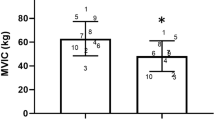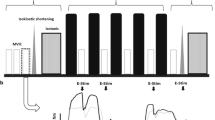Abstract
A method was developed to quantify erector spinae fatigue resulting from repetitive dynamic lifting in the sagittal plane. This method was tested with the data from eight male subjects lifting inertial loads of 19 kg and 17 kg during sessions of 20 min and 2 h, respectively. Surface EMG electrodes were applied over sites representing the bilateral lumbar and thoracic erector spinae and external oblique muscles. Maximal and submaximal isometric trunk extensor contractions were performed at the start, intermittently throughout, and at the end of the dynamic lifting trials, within an apparatus designed to control spine posture in the upright standing position. These exertions were used to assess the decreases in strength, endurance and EMG mean power frequency (f w ) as well as the increases in EMG amplitude that have been shown to accompany muscle fatigue. The average of the group for extensor strength decreased 17% and 21% (P<0.05) and the endurance times decreased 60% and 62% (P<0.01) for the 2-h and the 20-min session, respectively. The average endurance time decreased at least 10% for each subject in each session. Strength decreased at least 10% in all but 2 of 16 cases (both in the 20-min session). The average decreases in f w were 12% (lumbar) and 17% (thoracic; P<0.05) in the 2-h sessions and 20% (lumbar; P<0.05) and 14% (thoracic) in the 20-min sessions. There was also a significant increase in EMG amplitude (P<0.05) for both muscle group in both sessions. In general, the measures used in this study appeared to be sensitive to the fatigue resulting from dynamic contractions. The main advantage of using a combination of myoelectric and mechanical indicators of fatigue was that it allowed for more informed decisions to be made concerning its existence and extent for each individual subject during each session. Often, the information provided by each variable was needed in confidently making these decisions.
Similar content being viewed by others
References
Andersson GBJ, Ortengren R, Herberts P (1977) Quantitative electromyographic studies of back muscle activity related to posture and loading. Orthop Clin North Am 8:85–96
Arendt-Nielsen L, Mills KR (1988) Muscle fibre conduction velocity, mean power frequency, mean EMG voltage and force during submaximal fatiguing contractions and human quadriceps. Eur J Appl Physiol 58:20–25
Bigland-Ritchie B, Woods JJ (1984) Changes in muscle contractile properties and neural control during human muscular fatigue. Muscle Nerve 7:691–699
Bigland-Ritchie B, Cafarelli E, Vollestad NK (1986) Fatigue of submaximal static contractions. Acta Physiol Scand [Suppl] 128:137–148
Broman H, Billotto G, DeLuca CJ (1985) Myoelectric signal conduction velocity and spectral parameters: influence of force and time. J Appl Physiol 58:1428–1437
DeLuca CJ (1986) Myoelectric manifestations of localized muscular fatigue in humans. Crit Rev Biomed Eng 11:251–279
DeVries HA (1968) Efficiency of electrical activity as a physiological measure of the functional state of muscle tissue. Am J Phys Med Rehabil 47:10
Dieen HJ van, Toussaint HM, Thissen C, Ven A van de (1993) Spectral analysis of erector spinae EMG during intermittent isometric fatiguing exercise. Ergonomics 36:407–414
Edwards RG, Lippold OC (1956) The relation between force and integrated electrical activity in fatigued muscle. J Physiol (Lond) 132:677–685
Genaidy AM, Asfour SS (1989) Effects of frequency and load of lift on endurance time. Ergonomics 32:51–57
Jorgensen K, Nicolaisen T (1987) Trunk extensor endurance: determination and relation to low-back trouble. Ergonomics 30:259–267
Jorgensen K, Jensen BR, Kato M (1991) Fatigue development in the lumbar paravertebral muscles of bricklayers during the working day. Int J Ind Ergo 8:237–245
Kondraske GV, Deivanayagam S, Carmichael T, Mayer TG, Mooney V (1987) Myoelectric spectral analysis and strategies for quantifying trunk muscular fatigue. Arch Phys Med Rehabil 68:103–110
Maton B (1981) Human motor unit activity during the onset of muscle fatigue in submaximal isometric isotonic contractions. Eur J Appl Physiol 461:271–277
Mayer TG, Kondraske G, Mooney V, Carmichael RW, Butsch R (1989) Lumbar myoelectric spectral analysis for endurance assessment: a comparison of normals with deconditioned patients. Spine 14:986–991
McNeil T, Warwick D, Andersson G, Schultz A (1980) Trunk strengths in attempted flexion, extension, and lateral bending in healthy subjects and patients with low-back disorders. Spine 5:529–538
Morioka M (1964) Some physiologic responses to the static muscular exercises. Rep Inst Sci Labour 63:6–24
Moritani T, Nagata A, Muro M (1982) Electromyographic manifestations of muscular fatigue. Med Sci Sports Exerc 14:198–202
Okada M, Kogi K, Ishii M (1970) Enduring capacity of the erectores spinae in static work. J Anthrop Soc Nippon 78:99–110
Person RS, Kudina LP (1968) Cross-correlation of electromyograms showing interference patterns. Electroencephalogr Clin Neurophysiol 25:58–68
Person RS, Mishin LN (1964) Auto- and cross-correlation analysis of the electrical activity of muscles. Med Elect Biol Eng 2:155
Petrofsky JS, Lind AR (1978) Metabolic, cardiovascular, and repiratory factors in the development of fatigue in lifting tasks. J Appl Physiol 45:64–68
Petrofsky JS, Glaser RM, Philips CA, Lind AR, Williams C (1982) Evaluation of the amplitude and frequency components of the surface EMG as an index of muscle fatigue. Ergonomics 25:213–223
Roy SH, DeLuca CJ, Casavant DA (1989) Lumbar muscle fatigue and chronic lower back pain. Spine 14:96–105
Seidel H, Beyer H, Brauer D (1987) Electromyographic evaluation of back muscles fatigue with repeated sustained contractions of different strengths. Eur J Appl Physiol 56:592–602
Simonson E, Weiser P (1976) Psychological aspects and physiological correlates of work capacity and fatigue. Thomas, Springfield, Ill
Smidt GL, Blanpied PR, White RW (1989) Exploration of mechanical and electromyographic responses of trunk muscles to high-intensity resistive exercise. Spine 14:815–830
Stokes IAF, Rush S, Moffroid M, Johnson GB, Haugh LD (1991) Trunk extensor EMG-torque relationship. Spine 12:770–776
Suzuki N, Endo S (1983) A quantitative study of trunk muscle strength and fatigability in the low-back-pain syndrome. Spine 8:69–74
Troup JDG, Chapman AE (1972) Changes in the waveform of the electromyogram during fatiguing activity in the muscles of the spine and hips: the analysis of postural stress. Electroencephalogr Clin Neurophysiol 12:347–365
Viitasalo JT, Komi PV (1977) Signal characteristics during fatigue. Eur J Appl Physiol 37:111
Vink P, Velde EA van der, Verbout AJ (1987) A functional subdivision of the lumbar extensor musculature: recruitment patterns and force-RA-EMG relationships under isometric conditions. Electroencephalogr Clin Neurophysiol 28:517–525
Author information
Authors and Affiliations
Rights and permissions
About this article
Cite this article
Potvin, J.R., Norman, R.W. Quantification of erector spinae muscle fatigue during prolonged, dynamic lifting tasks. Europ. J. Appl. Physiol. 67, 554–562 (1993). https://doi.org/10.1007/BF00241654
Accepted:
Issue Date:
DOI: https://doi.org/10.1007/BF00241654




